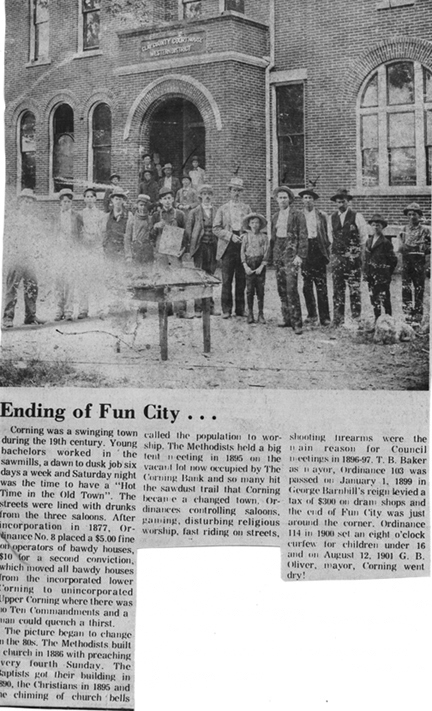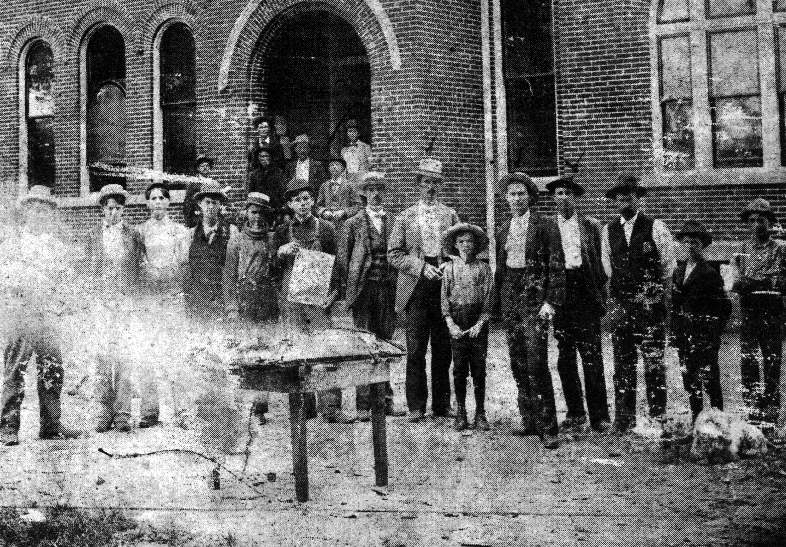


The Fiery Ending of Fun City
By J. M. Oliver, Jr.
Corning was a swinging town during the 19th century. Young bachelors worked in the sawmill, a dwan [sic] to dusk job six days a week and Saturday night was the time to have a Hot Time in the Old Town! The streets were lined with drunks from the three saloons. After incorporation in 1877, Ordinance No. 8 placed a $5.00 fine on operators of bawdy houses, $10 for a second conviction, which moved all bawdy houses from the incorporated lower Corning to the unincorporated Upper where there were no ten commandments and a man wher [sic] raise a thirst. The most noted operator, Sara Mullins, held forth at the corner of Pine and West Second. The Old Kentucky Saloon, at First and Main, operated a gambling den under the attic roof. Entrance after dark was made via a lean to roof at the rear! The incorporation nearly went busted with free sinning available to conveniently. So Upper Corning was annexed in August 1880 by a vote of 21 to 1, if the madams had been allowed to vote there would have been no annexation.
"The picture began to change in the 80s. The Methodists build [sic] a church in 1886 with preaching every fourth Sunday. The Baptists got a building in 1890, the Christians in 1895 and the chiming of church bells called the population to worship. The Methodists held a big tent meeting in 1895 on the vacant lot now occupied by The Corning Bank and so many hit the sawdust trail that Corning became a changed town. Ordinances controlling saloons, gaming, disturbing religious worship, fast riding on the streets, shooting fire arms were the main reason for council meetings in 1896;97 during the T. B. Baker term as mayor, Ordinance 103 passed on January 1, 1899 in George Barnhill's reign levied a tax of 300 on dram shops and the end of Fun City was just around the corner. Ordinance 114 in 1900 set an eight o'clock curfew for kids uner [sic] 16 and on August 12, 1901 G. B. Oliver, mayor, Corning went dry!
"This L. D. Oaks photograph made in front of the new brick courthouse pictures the last act, the gambling den had been raided and the table seized for burning. From left to right, J. W. Harb, circuit clerk, is standing on the court house [sic] steps. J. N. Moore, Usher Wells, and W. G. Smith, deputy sheriff who made the raid. Anyone knowing W. G.'s son, Floyd, will know the family resemblance. On the extreme left is the white frame courthouse that served the Western District from 1881 until 1900. It was sold to Joseph Dudgeon after the Dudgeon Hotel burned in 1901 and was moved to Chestnut and Second to become a four apartment dwelling!
"L. D. Oaks' pictures bear a charmed existence. The writer has been hunting for this one since 1965 and it surfaced in the attic of the Fred Arnold home. --Photograph courtesy of Mrs. Dorlene Arnold."
Submitted by Danny Moore